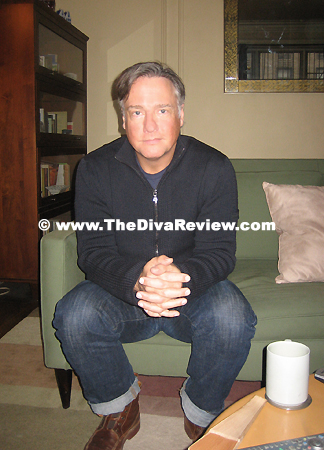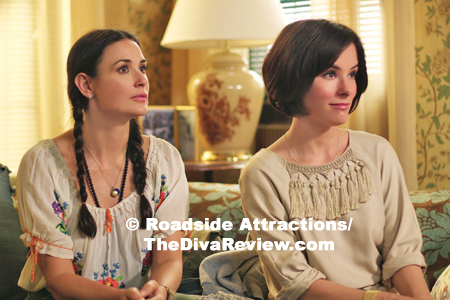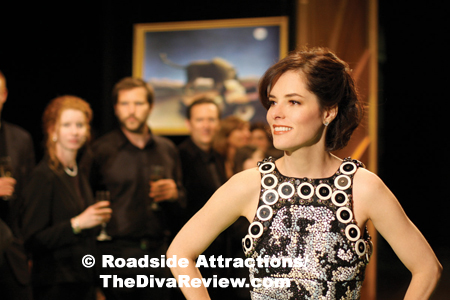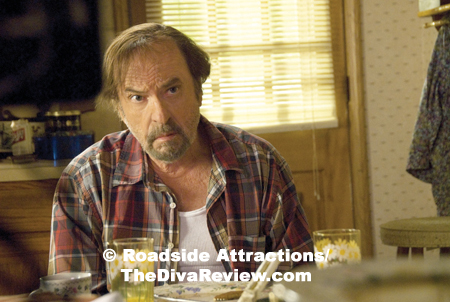
Bittersweet as its title implies, Happy Tears is writer/director Mitchell Lichtensteinís darkly funny look at the inner workings of a family in crisis and their occasionally off-the-wall coping mechanisms. Lichtenstein chatted with me about making his second feature after 2007ís audacious and hilarious Teeth.
Dig it!
Happy Tears
Writer/Director Mitchell Lichtenstein
 The
Lady Miz Diva: In Teeth, your protagonist was a young girl & in Happy
Tears, Jayne and her inner workings are the focus. Where does the
insight to your female characters come from?
The
Lady Miz Diva: In Teeth, your protagonist was a young girl & in Happy
Tears, Jayne and her inner workings are the focus. Where does the
insight to your female characters come from?
Mitchell Lichtenstein: The glimpses into her world came from the inception. The idea for the whole thing came first from germ of the character; someone who really has trouble facing difficult reality and goes off into something else and that is probably pretty autobiographical because my first instinct is first to shy away from any difficult reality. {Laughs} Iíve trained myself somewhat out of that, but this character does that and those kind of more trippy moments of hers; from the beginning of putting it together they were always integral to understanding who she is. And then also, that offered a whole other visual palette that you wouldnít have in a family comedy.
LMD: What was the inspiration behind Jayneís psychedelic inner world? Were you hesitant that those scenes might distract from the narrative?
ML: I wrote it over seven years, as I was writing Teeth and sometimes I had more in, and it came back to when did I feel it really needed to be with her in that place and not just when it was fun to do it. There were times when it wouldíve been fun to do it, but it didnít seem so crucial to be with her there. I had different ideas over the years in developing it: She had been introduced, since being with her husband, into the art world. Each one was going to be in the different style of an artist. {Laughs} Ultimately, what I wanted was that even though they were computer-generated, you always felt it was from the brain of this character, not we were going into Avatar - this big budget thing that suddenly turned into a big movie. Itís still just this woman; it would only be as fantastical as she could really think of.
LMD: The cast of this film is on a whole other tier of fame than Teeth. How did you assemble such a great ensemble?
ML: I was lucky. I think they were all really drawn to the script. It started with Parker {Posey}, once I started thinking about casting she seemed perfect for it and luckily she responded and then it was about finding someone who would be a good contrast and match with her, and when Demi {Moore} came up, I just thought that, a) Iíd believe in the sisters and Demiís sort of level-headedness and groundedness and authority was a good contrast to Parkerís characterís flightiness. Sheís sort of more of the air and Demiís character is more of the earth. And besides their personal characteristics that seemed right for it; to me it was really interesting to see the two of them in a movie together because they are from such opposite ends of Hollywood. To me, just to see them rubbing up against each other was something that I would want to see.
 LMD:
I think a lot of people are used to seeing Parker Posey in more
experimental independent productions, but indie is not a word one
associates with Demi Moore. Iím guessing this film cost less than G.I.
Janeís hairdressing budget. How did she come to play Laura, which is a
pretty unglamourous role? Was she up for it all?
LMD:
I think a lot of people are used to seeing Parker Posey in more
experimental independent productions, but indie is not a word one
associates with Demi Moore. Iím guessing this film cost less than G.I.
Janeís hairdressing budget. How did she come to play Laura, which is a
pretty unglamourous role? Was she up for it all?
ML: Oh yeah, once she was on board, she said that she really liked the script. She had always loved Parkerís work, so she wanted to work with Parker, she was happy to do something where the main characters were women and she liked Teeth a lot too, so once she was on board, she was great. She knew what she was in for.
LMD: Speaking of knowing what one is in for, how did you convince Ellen Barkin to agree to play and look like Shelly the crackhead?
ML: Honestly, Ellen went way in it. She made herself look a lot worse than I would have dared to ask her. I mean, it was clear off the page that Shelly has to look like hell, but she really took it a hundred and ten percent. The yellowing of the teeth, I wouldnít have dared to ask it. It was clear sheíd have to have a bad wig and the dirty fingernails and stuff, but she was brave and she had fun doing it.
LMD: How much debate went into how graphic the clean up scene would be?
ML: Well, I tried it without too graphic a depiction of the poo, and what I realised I liked about having the sort of quick shot of it is that it makes you get viscerally closer to Jayne and she turns from it and goes to this happier place. And I think many of us in the audience, when we see that we turn cos we really donít wanna see it, either, and I think in that moment we are like Jayne and I think it brings you closer to that character. I felt in the edit that didnít have that, I felt a little removed from Jayne and I think we really want as much as possible to be with her. Sheís such an unusual character. Any chance to bring you close to what sheís going through, I took that.
LMD: In the press notes you make a point of saying this story is not autobiographical, but why then did you make Jayneís husband, Jackson the son of a famous artist as you are the son of a famous artist {Pop Art icon, Roy Lichtenstein}?
ML: I felt it was important to say because it was inevitable that people would assume that aspect was autobiographical. I wanted to do something in the art world because itís a world I know something about and I could believably sketch in in broad strokes that doesnít have much screen time, so I could have this world established very quickly. The character came out of me thinking after my father died, what if I really had to take on the responsibility of his estate and dealing with his artwork and exhibitions and stuff? And I donít, we have a foundation that handles that stuff very well and all, but if I didnít have that, or if he and I had some unfinished, messed-up relationship where I felt like I had to prove something to him posthumously the way Jackson does, what that would be like and how unsuited I would be to the task and how unsuited one person would be to the task.
 LMD:
You make great use of Cy Twomblyís work in the opening credits, but I
could swear in the background of Jayne inner art party, thereís
something of your dadís there.
LMD:
You make great use of Cy Twomblyís work in the opening credits, but I
could swear in the background of Jayne inner art party, thereís
something of your dadís there.
ML: There is, itís the Happy Tears, painting. {Laughs}
LMD: Have Rip Tornís recent difficulties given the film undue attention?
ML: Not that much, really. Honestly, when I heard about the last thing, I just thought, ĎFree publicity!í {Laughs} I mean, he didnít hurt anyone, you know? The bank did look like a house and I donít think he lives far from there. Anyone could make that mistake! {Laughs} I think itís public knowledge that heís in rehab now, and I think thatís great. Thatís apparently where he should be.
 LMD:
Was he fine on the set?
LMD:
Was he fine on the set?
ML: Yeah, I mean, heís an irascible character and you know that going in and heís been like that forever and thatís what you get. Heís a brilliant actor and you sometimes get that and I would love to work with him any time.
LMD: What are you working on next?
ML: Iím adapting a novel called Angelica that came out a couple of years ago by Arthur Phillips. It has some themes closer to Teeth; itís a gothic psycho-sexual ghost story. Itís really cool, I love the book.
~ The Lady Miz Diva
Feb. 16th 2010
© 2006-2022 The Diva Review.com
|
|






